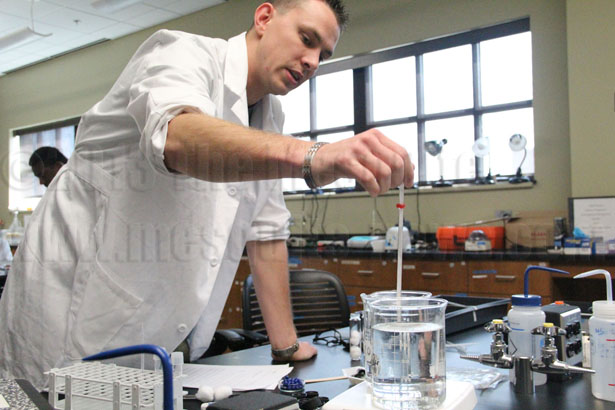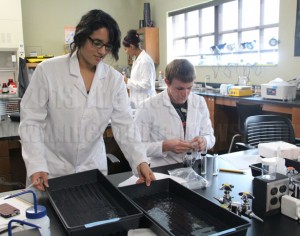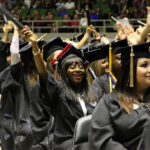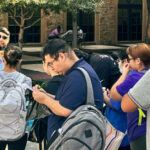
By Laura de Leon
This is the first article in a series about the development of Texas’ Water Conservation and Technology Center. Part I provides an overview of the center’s development, collaborative partners and future opportunities for student research at Texas A&M-San Antonio.
Part II will give an overview of the center’s projects, including grey water management (Coming March 7).
As Texas endures prolonged drought and water scarcity, the university is working alongside local agencies to find potential solutions.
Last spring, Texas A&M University System Chancellor John Sharp announced the formation of a new Texas A&M system center named the Water Conservation and Technology Center. The goal, according to a university press release, is to “address multiple water issues and develop solutions for Texas.”
Today, plans are underway for student research opportunities in collaboration with the Water Conservation and Technology Center and the collaborative is cited in a recently released university economic impact study as a type of “vital learning.”
A part of the Texas A&M System, the center is administered by the Texas Water Resources Institute in partnership with the Texas Center for Applied Technology. Public and private partnerships are also involved to help fund and contribute to research opportunities which aim to meet future water supply needs and take action on emerging water problems, according to the center’s website.
Some of the A&M System partnerships along with A&M-San Antonio that are involved include, Texas AgriLife Research, Texas AgriLife Extension Service and Texas Engineering Experiment Station.
Jose Rodolfo Valdez Barillas, assistant professor of biology, serves as liaison between the center and A&M-San Antonio. He also contributes to planning projects and developing the academic infrastructure that will allow for student involvement and potential research opportunities.
“Right now it is establishing the foundation and framework,” Valdez Barillas said, explaining that when students are involved there must be very specific goals when programs and research opportunities are developing. Advance planning will allow them to be successful, he added.
Faculty have taken advantage of research and travel opportunities to prepare for the center’s future development. Last May, the San Antonio Hispanic Chamber of Commerce took leaders from this university, including President Dr. Maria Ferrier and two biology faculty to Israel to explore economic development opportunities, information technology, cyber security, water conservation and irrigation technology. While there, faculty visited the Israel Ministry of Energy and Water Resources. Read more
Although there is no physical building dedicated to the center at the university at this time, AgriLife and the TEES have reserved 112 acres on the university property dedicated to the WCTC.
The primary goal for the center is to contribute to increasing the water supply and efficiency, according to Calvin Finch, director of the Water Conservation and Technology.
According to the U.S. Drought Monitor release last week, at least half of the state of Texas is in a severe drought. With current drought problems apparent, finding water solutions is becoming a common topic in the state and has even made it to this year’s legislative session. State leaders have proposed bills in the Texas House and Senate to finance water infrastructure projects.
“As important as the water challenge is in Texas, we need our top universities to be organized and mobilized to help address that issue,” Finch said.
With the help of scientists, engineers, water professionals, and eventually student researchers, the center will focus on applied research and development, testing and validation, and training focused in four areas: water conservation, water reuse, groundwater desalination and energy development with water use.
The center currently has two full-time employees based in San Antonio: Finch and hydrogeologist Khristine Uhlman. All other researchers and active help, such as engineers and extension educators, are borrowed from the collaborative to work on specific projects, Finch said.
With an abundant amount of collaboration, having all types of experienced workers in different industries is key to the success of the water projects. They plan to have a database that helps them keep track of who is available and their specialties.
Finch, a former director of water resources and director of conservation for the San Antonio Water System, and representative to the Edwards Aquifer Recovery Implementation Program, now works from his South Side office in the Texas A&M Engineering Extension Service building on South Presa Street.
In a recent interview in his office, Finch discussed how SAWS has contributed a great deal to help conserve and create better water use. At this time, he not only coordinates projects that focus on high priority water issues with the center, he takes part in the research and writes weekly articles on horticulture, water conservation and the environment for the San Antonio Express-News and other publications in the San Antonio area.
The center is partially funded by TCAT and AgriLife but this is not a traditional organization, Finch said. Usually engineers and extension educators work in different directions and that’s not the most efficient way to find solutions — we need both to work together, he said.
Funding for the programs and research come from multiple resources such as soft money (outside funders), state and private investors.
The center is currently working on multiple water projects that pursue better use of conservation and reusing water, according to multiple sources who are partnering together on the project. As the program develops, members hope to incorporate student researchers from A&M-San Antonio who will have the opportunity to work with hands-on projects. One potential project includes researching how greywater can be used, according to Valdez Barillas and Finch.
All center projects, both agree, will benefit not only the state and its water development, but will bring opportunities for students, educate the community and begin to ensure water availability and conservation for future generations.

Center prompts faculty expansion
A&M-San Antonio is in the process of hiring two new biology professors. One will be directly involved in the center’s research. Last week, Barillas announced to faculty that biology faculty candidates would be on campus and were encouraged to meet the candidates.
In the job posting listed Oct. 10, 2012 on HigherEdJobs.com, the university announced its intent to hire a full-time, tenure-track assistant professor of biology. The job posting included that the position would contribute to the collaborative research projects with the center, along with teaching at an undergraduate level.
Valdez said this professor will research water issues related to microbes from the standpoint of drinkable water quality and waste water treatment. He said the potential biology professor is currently in the interviewing stage and will begin Fall 2013.

Student involvement
Valdez Barillas said one goal for the center will be to eventually have students enrolled in classes that will give them access and research opportunities. At this point in time, he said potential opportunities for student involvement in the university setting may also include internships and work-study programs.
Since A&M-San Antonio is still in the accreditation stages, Valdez Barillas said they cannot accredit these projects but “it is in the works.” The university, currently accredited through Texas A&M-Kingsville, has submitted an application to the Southern Association of Schools and Colleges for independent accreditation.
As the university develops its own programs, Valdez Barillas said faculty are taking time to understand which programs are necessary for an urban community and what is going to be useful in the future. The administration will make the final decision, he said.
“We need to be very careful so that when we open a program we know that we are going to have an interest from the students and there is going to be a field for them to go out into and get jobs and work.”
Right now, Valdez Barillas said the university is indirectly connected with the WCTC center wherein students can gain some experience.
“As far as a curriculum development, we are not there yet, but we will be there soon,” Valdez Barillas said.






